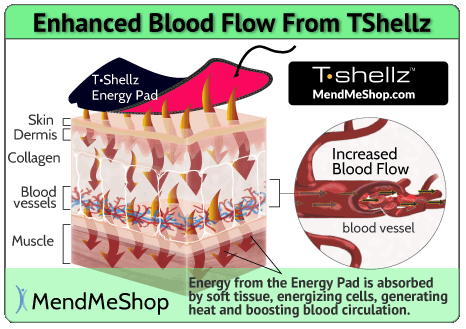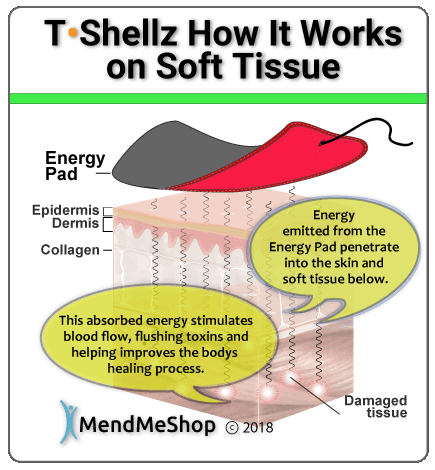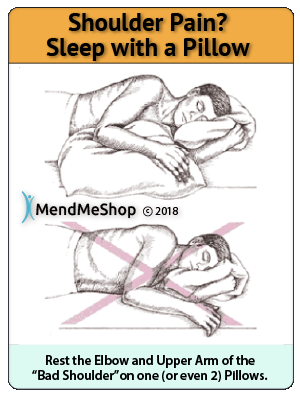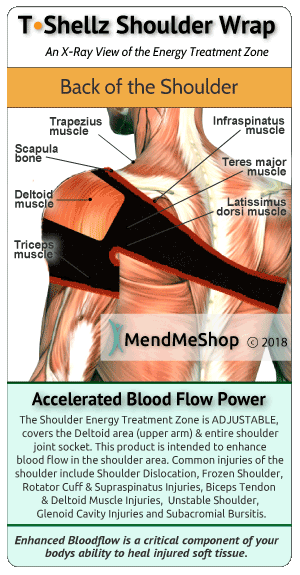If your doctor has set out a path of treatment for recovering from your frozen shoulder, remember it is a slow process and you need to give treatment time to work. Even with stretching your shoulder daily and applying the conservative treatments (cold and heat via use of the TShellz Wraps®), it still may take months to restore normal shoulder movements.
The aggressiveness of your rehabilitation efforts to overcome frozen shoulder and your injuries ability to heal will depend on a variety of factors including (but not limited to):
Don't be discouraged! Your hard work by sticking to your 'path of treatment' will pay off and you will get your life back! Start out slow, and do not push yourself too much at first. Let your pain be your guide. If an exercise hurts too much, modify it or stop doing it. It is important to stretch your whole shoulder, 5 times a day, holding each stretch for at least 30 seconds. You should feel your shoulder stretching. If stretching does not cause you pain that lasts at least 5 minutes, then you have not stretched hard enough. If stretching causes pain that last longer than 15 minutes you have stretched too hard.
Stage 1 - Freezing; you will slowly have more and more pain. As the pain worsens, you lose more use of your arm and shoulder. Freezing typically lasts from 6 weeks to 9 months. You will be in a lot of pain and your doctor will suggest cold compression or medication to control your pain levels. NO aggressive exercises or PT should be undertaken at this stage, just daily use of the Shoulder TShellz Wrap® to keep it from completely losing range of motion and the use of a Cold Compress or Ice Pack when there is swelling or inflammation. Doing too much at this point can lead to more damage and a more difficult time completely recovering from frozen shoulder.
Be wary of using a sling and/or shoulder brace too frequently in Stage 1 of a frozen shoulder condition. This may prevent necessary movement in your shoulder, and can make the situation worse. It is helpful to limit painful movements, but remember to perform at least gentle movements around your shoulder to keep circulation and blood flowing.
Stage 2 - Frozen; During the 4 to 6 months of the "frozen" stage, daily activities may be very difficult. Your pain levels will have reduce quite a bit since stage 1, but the stiffness remains. This will be the time you become more active by starting PT or at home exercises. Your shoulder will still be stiff and in pain but less pain than before. You will be working hard to break up scar tissue that has formed inside the joint capsule - the goal is to regain as much range of motion as possible.
Stage 3 - Thawing; Shoulder motion slowly improves during the "thawing" stage. Complete return to normal or close to normal strength and motion typically takes from 6 months to 2 years. Your home stretching exercises and/or PT will be more aggressive and you can tolerate more movement of your shoulder. At this point of your recovery stretching is very important to continue breaking up the scar tissue so your body can rebuild with healthy tissue. You will ultimately be working to regain 100% function of your shoulder.
No matter who you are or your reasons, if you want to properly deal with your frozen shoulder injury and minimize the negative impact it will have on your life, you need to speak with your doctor about adding a Shoulder TShellz Wrap to your home conservative treatment regimen. We have many happy customers that have recovered from frozen shoulder faster than they expected and significantly reduced their pain during treatment and exercises.

When you first contracted frozen shoulder disease, you may have had a hard time moving your arm and/or shoulder. Maybe you had to crawl out of bed with limited use of your arm and went to the medicine cabinet to reach for some pain killers. Movement induced strain causes micro-tears which cause inflammation - and inflammation causes more pain.
As the process continues your body will fill in these micro-tears of your shoulder with dense, brittle tissue called "scar tissue". The human body will use scar tissue as a temporary solution and will try to build the scar tissue as fast as possible to bind tears together. Scar tissue can form fast to bring together the edges of a tear(s), but working fast doesn't mean that the job's done right. When scar tissue forms it doesn't come together as neatly as regular (healthy) tendon/ligament tissue would. Scar tissue fibers will lay down over top of your tear in a cluttered, messy and jumbled up way.
The scar tissue that forms in your shoulder issue will be unorganized and won't line up properly with the healthy tissue surrounding the tear. This scar tissue will attach to everything in and around your shoulder injury including the surrounding healthy tissue as well. This can result in a long-term fusing together of your tendons/muscles/ligaments that drastically stiffen your shoulder, reducing mobility, and making your injury even more painful!
Scar tissue is the MAIN reason why your shoulder injury just hasn't healed. Even when the inflammation is gone, scar tissue will still be there to wreak havoc on your shoulder movement and range of motion. On-going issues with scar tissue can even result in the return of frozen shoulder or a different injury such as a rotator cuff tear.
Scar tissue will form fast to deal with a strain or tear to one of the tendons, ligaments, or muscles in your shoulder, but working fast doesn't mean that the job's done right. When scar tissue forms it doesn't come together as neatly as regular (healthy) tissue would. Scar tissue fibers will lay down over top of your tear in a cluttered, messy and jumbled up way.
This is how scar tissue works. The scar tissue that forms in your shoulder joint will be unorganized and won't line up properly with the healthy tissue surrounding the injury site. This scar tissue will also attach to everything in that area, including the surrounding healthy tissue as well. This can result in a long-term fusing together of the soft tissue in your shoulder that stiffens your joint reducing your mobility and making your injury even more painful!
Scar tissue is a major problem especially when it comes to frozen shoulder injuries that can sometimes take up to 2 years to heal!
Time is the only way for your frozen shoulder to heal completely, but with committing to a home conservative treatment regimen including the use of a Cold Compress or Ice Pack, exercise/stretching and the application of a Shoulder TShellz Wrap® at the right times, you will experience less pain, and in most cases, your recovery will progress at a faster rate due to enhanced localized blood flow, and reduced risk of reinjury.
You can help minimize scar tissue growth and reduce risk of further injury to your shoulder by increasing blood flow to the area. Treating yourself with a Shoulder TShellz Wrap is the easiest and most effective way to achieve this.
When applied before activity or work, a Shoulder TShellz Wrap is intended to relax and lengthen your soft tissue to help improve your range of motion and prevent atrophy (wasting away) of the tendons and ligaments in your shoulder and arm. Overall, continued treatment with the Shoulder TShellz Wrap will maintain good health in your shoulder and significantly reduce your risk of re-injury.
Now this is where stretching your shoulder to recover from 'frozen' shoulder is key. Before stretching, exercise (or any movements that you expect to aggravate your shoulder) apply the Shoulder TShellz Wrap®. Use of the Shoulder TShellz Wrap® will increase blood flow in the shoulder while gently warming your soft tissue. This warming of soft tissue increases elasticity and flexibility of the shoulder, decreasing the risk of shoulder strain while undergoing exercise or stretching. Your hard work will help prevent build up of more scar tissue and allow your shoulder to heal more quickly. Once you start doing this you will regain more range of motion, be more pain free and life will return to normal more quickly for you.
If pain and inflammation persist, you can see your physician to investigate injections or topical medications, which may help reduce swelling and inflammation. Your physician will determine whether this is worthwhile on a case-by-case basis.
Many, or even all of the above options can be very helpful but you may see a common theme: be careful not to overexert your shoulder if you are on a pain blocker as this can easily prolong the duration of your frozen shoulder.
Promoting blood flow within a muscle or soft tissue injury to help the body heal itself is a concept that has been utilized for centuries. Oxygen and nutrients, carried within the blood, are critical for the body to heal itself. Without proper blood flow, recovering from an injury or condition will be delayed...sometimes for a very long period of time.
Blood Flow - the natural healing process in your body - needs assistance when it comes to frozen shoulder because blood flow is greatly restricted when your shoulder is immobile. In such cases, an effective treatment will increase blood flow to the area while the joint is immobile. This increase in blood flow will help maximize the body's own capability to heal itself.
Even though the concept is simple, improving blood flow can be difficult. When the injury is joint related, the challenges are even greater. Traditional methods require your muscle to move to promote blood flow (physio), but that same motion that promotes blood flow can at times lead to making your pain and condition worse.

Most people we deal with tell us these scenarios have happened to them many times in the past. The real challenge is how do you promote blood flow to the shoulder injury site without causing further injury? This goal is further complicated by the fact the shoulder (and muscles controlling the shoulder joint) are involved in the majority of the physical movements we perform each day.

An injury to one shoulder muscle can easily lead to straining in other areas, making an overall recovery hard to initiate. For example, a serious muscle strain in the right rotator cuff can often lead to over-straining of the left rotator cuff. Most commonly, the injury occurs on the dominant side, so the risk of straining the other (weaker) side increases. The longer the injury (and corresponding pain) persists, the greater the chance that you will sustain more strain from overcompensation, eventually leading to issues in those areas as well. To minimize potential secondary injuries, know that it is important to deal with your muscle injury quickly and completely.
Using the TShellz Wrap is truly a unique experience. Within moments of applying an TShellz Wrap to your shoulder, you can feel the healing sensation due to the increase in blood flow deep within the area. During a treatment, and for quite some time after you finish, the treated area will feel gently warmed and more relaxed. It's a very soothing sensation and extremely effective.

The TShellz Wrap® is an FDA Registered Medical Device and is completely safe for patients to use by themselves, and at home. The TShellz Wrap® shell is made of neoprene and this helps shape the flexible Energy Pad to mold around the contours of the joint, ensuring there is an even distribution of safe energy within the coverage area. Once treatment is complete, you also have the option of tightening the straps to provide light compression support for your injured joint. You can also unplug the device from the power supply enabling you to move around the home, office or clinic freely and still use the wrap for support and comfort.
With a Shoulder TShellz Wrap®, your shoulder is constantly being fed with healing, nutritious, oxygen and energy filled blood. This is exactly what your body needs to heal.
The Shoulder TShellz Wrap = The Perfect Device for Localized Enhanced Circulation Response
In order to get maximum blood flow to your shoulder, you need to help your body stimulate blood flow. A TShellz Wrap® is the fast, easy and pain-free way to increase blood flow, relieve pain and increase elasticity of tissue in the treatment area. It's the key to dealing with your injured shoulder properly.
Regular treatments with a Shoulder TShellz Wrap can reduce pain and stiffness from scar tissue and increase overall flexibility in your shoulder. Increased blood flow will whisk away damaged tissue, toxins, and any bacteria in or around your injured shoulder, reducing pain, inflammation while boosting the body's own repair process. Increasing blood flow will also increase the amount of oxygen that's being sent to your injured tissue AND boost your tissue's ability to absorb oxygen. (reference: 1)
Over the last 2 months, you have felt your shoulder stiffening and the increased pain and discomfort at night is interrupting your sleep patterns. You went to your physician 1 week ago and have received a stage 1 frozen shoulder diagnosis.
You should use COLD on your shoulder multiple times per day (as advised by your physician) to help ease the pain. Further to this, we advise you use a couple pillows to prop your arm up to a more comfortable position during sleep.

It has been just over 2 years since you have last painted on the canvas and since it was such a nice morning, you got out your easel out of the basement and started painting once again. You know your shoulder isn't as limber as it was, but you aren't feeling much pain as you are working the brush. You stopped for lunch and now you feel a dull ache in your shoulder. You decide to not return to painting until your shoulder feels better (you stopped the activity that caused the ache).
If the pain level is low, use heat (Circulation Boost) should be used to relieve the dull ache in your shoulder(s) and encourage healing of your damaged tissue.
If the pain level is quite high, use a Cold Compress or Ice Pack to get the pain and swelling down.
The next time to choose to undertake an activity in stage 3 of frozen shoulder, use the Shoulder TShellz Wrap® about an hour before undertaking the activity. We suggest to do this as the TShellz Wrap® treatment will help increase flexibility and elasticity of the shoulder - allowing you to undertake the activity with a reduced risk of re-injury.


If you have a chronic shoulder injury that keeps getting re-injured you should use a Shoulder TShellz Wrap before activity to loosen up your tissue (making it more flexible). This treatment is shown to increase the elasticity (flexibility) of the soft tissue in and around the treatment area, making it more pliable for activity and less likely to re-injure.
Sometimes we feel pain while doing a certain activity - should you still use Circulatory Boost? Using a TShellz Wrap in the morning before you start your day or before activity can help to boost blood-flow and reduce risk of further strain or injury. Use cold part-way through your day after you have been active so you can decrease pain and inflammation from the flare up.
If you think you might require shoulder surgery click here.
If you have undergone shoulder surgery and are looking for rehabilitation information, click here.
Increasing flexibility and strength in the shoulder is a key component to help avoid worsening your frozen shoulder. For this reason, we have created ebooks that outline specific shoulder exercises / stretches for our clients undergoing shoulder injury recovery.
Even when you're injured and in pain you need to keep moving to break-up scar tissue that's forming in your tendons and ligaments in your shoulder.
Moving when you're injured is hard. Since moving while injured can be painful most people think it's better to stop moving, rest their shoulder and hope that their shoulder injury will heal all on its' own. Even though rest is important to recovery, too much rest during the recovery process will increase the amount of scar tissue in your shoulder.
During the healing process your body will fill in soft tissue tears with dense, brittle tissue called "scar tissue". The human body will use scar tissue as a temporary solution and will try to build the scar tissue as fast as possible to heal a tear in the soft tissue. Scar tissue can form fast to bring together the edges of a tear, but working fast doesn't mean that the job's done right. When scar tissue forms it doesn't come together as neatly as regular (healthy) tendon/ligament tissue would. Scar tissue fibers will lay down over top of your tear in a cluttered, messy and jumbled up way.
Shoulder Joint Atrophy is arguably a bigger issue than scar tissue. Whether you have a shoulder injury or have recently had a shoulder operation, you will find that the joint has a more limited range of motion than you had before. In most cases, this is due to atrophy - the shortening of connective tissue in the shoulder due to inactivity. In cases where atrophy exists, it is very important to stretch and do gentle exercise to nip this problem in the bud before it becomes a chronic (long-lasting) issue. If you are currently recovering from a shoulder injury speak with your physician about stretches and exercise.
When done properly under recommendation of a physician, shoulder stretches have a proven track record of assisting in the speedy recovery of many patients. This is without doubt, the third and final essential tool for complete shoulder injury recovery. Once a patient deals with the swelling and inflammation through use of a Cold Compress or Ice Pack, then begins the Circulatory Boost process by using home treatments with the TShellz Wrap, all the while keeping rested to keep stress off the injury. Once the injury has healed, it is time to take the third and final step to recovery by beginning a shoulder rehabilitation stretching regimen.

The final step in frozen shoulder rehabilitation is stretching - this is a critical step for complete recovery from your frozen shoulder! Working to align the healthy new tissue and break-up scar tissue is an important part of your recovery from frozen shoulder.
It is important to note that exercising and stretching is most helpful during the 2nd and 3rd stages of the frozen shoulder condition. Exercises or stretching during Stage 1 ('freezing') could be more damaging to your shoulder extend your recovery process even longer. This is when you are in the 'frozen' and 'thawing' process - meaning you are experiencing the worst of your injury with maximum limitation on your mobility. With the guidance of your doctor or physical therapist, as to what frozen shoulder exercises work best for you an your specific range of shoulder movements.
It may seem hard to believe, but our Shoulder TShellz Wraps will assist you in recovering from your frozen shoulder faster. Reduce your chance of suffering from degenerative conditions (like arthritis) by maximizing blood flow where it's needed most and reducing swelling / inflammation induced pain.
If you are suffering through a shoulder injury, we strongly believe that we can help you, and we have thousands of happy clients to back this claim. You are welcome to try our products for a 60 day period.. If you are committed to following the treatments outlined in the product instructions we are very confident that our TShellz Wraps will aid you immensely. If you do not receive the benefits that countless of our other customers have experienced from our products, call us, mail the product back to us and we will provide you with a full product refund.
Our online shop accepts Visa & MasterCard as well as a PayPal Payment option.
We also encourage your to Call Our Office at 1-866-237-9608 (toll free continental NA) where we can answer any questions you have and/or take your order via phone.
Our customer service lines are open 5 days a week helping people understand their injuries and how to treat them. Simply call toll free 1-866-237-9608 to talk or place an order with one of our knowledgeable Product Advisers. They have the ability to answer questions and even put together a treatment plan for you.
North America Toll Free 1-866-237-9608
Outside North America +1-705-532-1671
Living with pain is never easy and we encourage you to call us with any questions regarding how our products might relate to your frozen shoulder condition. We will do our best to help.
Product Advisors are available 9:00 am to 5:00 pm Eastern Standard Time Monday to Friday.
Learn more about Shoulder Surgery and Post-Surgery Recovery
Learn more about about how the Circulatory Boost TShellz Wrap® helps with the healing process.
Learn more about which is better for your frozen shoulder injury - ice or heat
During your recovery, you will probably have to modify and/or eliminate any activities that cause pain or discomfort at the location of your soft tissue injury until the pain and inflammation settle. The more diligent you are with your treatment and rehabilitation, the faster you will see successful results!
Please be aware that this information is neither intended nor implied to be a substitute for professional medical advice. CALL YOUR HEALTHCARE PROVIDER IMMEDIATELY IF YOU THINK YOU MAY HAVE A MEDICAL EMERGENCY. Always seek the advice of your physician or other qualified health provider before using any of our outstanding products to make sure they are right for you and your condition or if you have any questions regarding a medical condition. Always see your doctor for a proper diagnosis as there are often many injuries and conditions (some very serious) that could be the cause of your pain.
© 2025 In.Genu Design Group, Inc. Contact Us